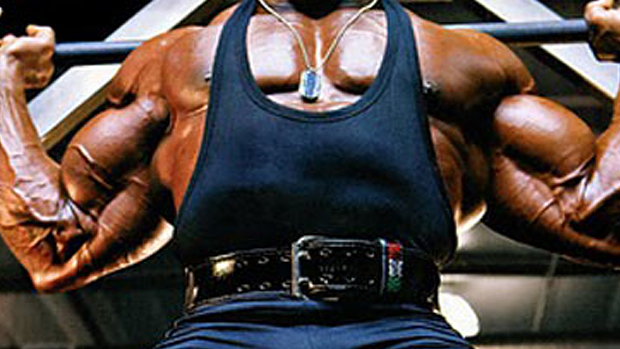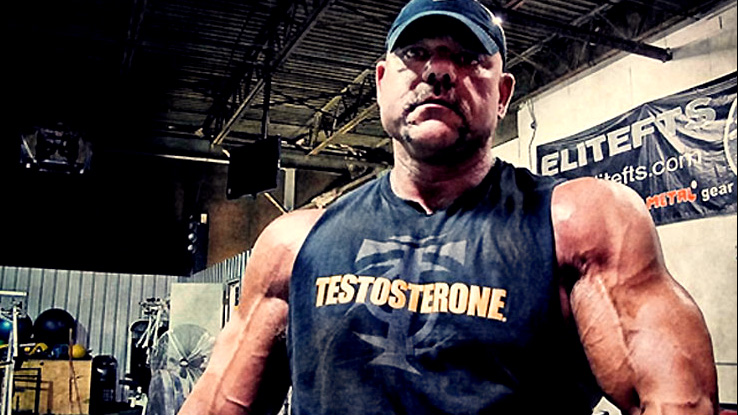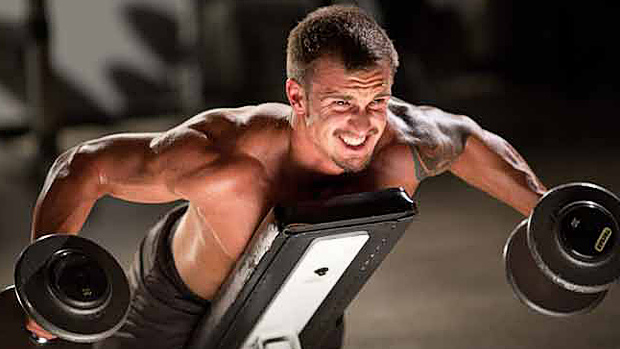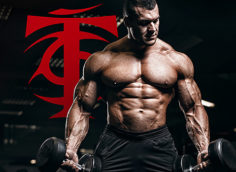"You talk the talk. Do 'ya walk the walk?"
– Animal Mother, Full Metal Jacket.
The Internet's a funny place. Anonymous almost by nature, it allows anyone to become anything, and the chance to adopt a fictional persona can be very tempting for some people.
That might be fine if we're talking about goblins, warlocks, or Night Elf Mohawks, but not when we're discussing training or nutrition... let alone when people are declaring themselves experts and giving out advice.
We've all seen the fat personal trainer in the gym who knows that your training and diet is wrong and theirs is right, but it's pretty hard to take bodybuilding advice from someone who looks like they spend more time at the 24-hour drive-thru than 24 Hour Fitness.
When it comes to Internet training, it's even easier to seem like you know what you're talking about even if you have as much successful training experience as a fugly girl with lockjaw has fellatio experience.
I checked with a few T NATION contributors to see what they've been up to in their own training and to make sure they're still fighting the good fight even while training clients, meeting deadlines, and running businesses. TC gave me specific instructions that if the phrases "water aerobics" or "Tony Little's Gazelle" came up, it'd be the last you ever saw of these guys.
– Chris Colucci
The Handsome Fella: John Romaniello

I've been experimenting with a lot lately. There's so much cool stuff going on in the industry that I like to spend a bit of time trying it all. I spent about three weeks playing around with Doggcrapp, which I liked and will spend more time with later on.
When I finish my current program, I plan on dedicating a solid month to working on Perfect Rep training, possibly with the Plazma™ (if for no other reason than my inbox is filled with questions about it and I don't have a legitimate answer to give). On top of that, the plan really looks great and I have a ton of respect for Mr. Thibby-dibby (as we call him in my household). I think there's a lot of potential there.
I'm 5'8"-ish and around 190 pounds, and I'm using a custom program designed for both fat loss and muscle gain that includes a unique type of rest-pause sets. Whereas traditional rest-pause incorporates small rests in between individual reps of a set to extend the total reps and time under tension, I'm basically using short rest periods throughout the entire set, so they're more similar to breathing squats.
I've been using this method on and off for about two years and it's exceptional for size, strength-endurance, and overall work capacity. Let's say I'm on the incline bench press. I'll use my 10-rep max and get all 10 reps with good form. On the last rep, I hold the locked out position for 5-10 seconds, taking deep breaths and trying to recover.
From there, I bang out as many reps as I can (usually about 6-8) before I hold the lock out for 15-20 seconds of deep breathing, and then I perform a few more reps. After those, I rack the weight completely, take about 15 deep, grateful breaths, then I grab the bar and rep out to failure one final time. All of this makes up one set... and I do two of these sets per exercise.
I'll map out each workout for 6-8 weeks at a time and make alterations as I go. I'll often switch the order of two or more workouts during a given week. During each individual workout, I let how I feel determine my weights.
Sometimes I feel like Mario with the star (self-high-five for my own Nintendo reference) and I'll go well-beyond my planned weights, sets, or reps. Other times, I might feel like shit and just be going through the motions, so there's no way I could use my planned weight. This happens to everyone, of course. On the rare occasion, I bail out entirely.
One thing that's been hugely successful, with my clients and myself, is just lifting heavy. At least one day each week, I use multiple sets of 4-6 reps with around 85-90% 5RM. I rotate the exercises every three weeks, but I always have one press, one pull, one deadlift variation, and one squat variation per session. These are my go-to workouts. They're fast, effective, draining, and they help keep me strong and dense year-round.
This training stuff is supposed to be fun. It's hard and it requires effort, sacrifice, and dedication, but it should still be a lot of fun. If you watch Pumping Iron or anything from that era, Arnold and the crew were having a blast. They worked their asses off, but in the midst of it, they enjoyed themselves. That's what we should all strive for.
When it comes to training for size, whatever type of training you enjoy the most tends to be the most effective. When it comes to training for fat loss, the style of training that's most effective is the one that makes you the most miserable.
In terms of the overall lifestyle, if you don't enjoy it on some level, you're destined to fail. Either you get something out of it – whether it's the physical enjoyment of a training session, emotional satisfaction from seeing results, or the social rewards of having a better body than most people – or you don't do it. Period.
The Functional Coach: Nick Tumminello

I try to look and be athletic so I can hang with my NFL, MMA, and bodybuilding clients when I'm training them. I'm 5'6" and 160 pounds, but my current training partner, Mark, is 6'1" and 245 and we push each other through some serious workouts.
People might think that some of the exercises or programs I use are unusual or unconventional, but I wouldn't give clients anything that I didn't already try first. A lot of the unique exercises I prescribe really come out of necessity; I find out how to train certain movements as the need arises (such as the grip strength needs of an MMA fighter).
It's not about wanting to do functional exercises just for the sake of doing them. For example, I hate pistol (front leg extended) squats because that's not a position you see in the sports world, but no exercise is really "non-functional." If your body can do the movement, then it's functional.
I had ACL surgery over a year ago, so my own training still includes a lot of proprioceptive work to keep my knee healthy. I also love rock climbing and training mixed martial arts down here with Team Ground Control, so I try to include those each week depending on my schedule.
To complement the climbing and MMA, I might include thick bar grip work and/or direct neck training on my upper body lifting days (but not on lower body days to avoid overlap with deadlifting). We also train barefoot a lot, especially with any lower body proprioceptive work.
Right now, my plan is basically an upper/lower split tweaked just enough so that some bodyparts and movements are still getting priority on certain days:
- Monday: Upper Body Push (with some pull)
- Tuesday: Lower Body Hip/Posterior Chain (with some general "leg" training)
- Thursday: Upper Body Pull (with some push)
- Friday: Lower Body Quads/"Legs" (with some posterior chain work)
The workouts begin with five or ten minutes of a dynamic warm-up for the bodyparts being trained that day. For most people, if you do some mobility work in your warm-up, you don't need to worry about also doing it in a separate session, unless there's something you really want to prioritize.
People also need to use common sense and focus on what applies specifically to you before following more general concepts. For example, if you've always had flexible hips, but your T-spine is screwed up from hunching over a computer all day, you might not need to do much hip flexor mobility work even though you're "supposed to." So, common sense and specificity are crucial.
After the warm-up, if it's an upper body day, I'll do a few basic light medicine ball throws for CNS activation. On lower body days, we do some plyometrics or speed drills for a bit of CNS training before getting to the weights.
I always end training sessions with some kind of conditioning. On upper body days, it's either using a hammer on a tire or some upper body complexes – 5-8 exercises, 5-8 reps per exercise for three total sets, moving fast the entire time.
On lower body days, it could be sled work, running sprints, or I'll hop on an Airdyne bike for sprints or intervals. I'll also cooldown from each workout with some basic stretching for the bodyparts that were trained.
I make sure that each lower body workout includes a double-leg exercise (like back squats or trap bar deadlifts) and a single-leg exercise (like single-leg deadlifts) to get enough work without overloading the spine and impairing overall recovery.
Because I'm basically training bodyparts twice a week, I alternate between two different set/rep patterns. One session will be 3-4x8-12 for hypertrophy training and the next workout for those movement patterns will be 4-6x4-6 for more of a strength focus.
One good rule of thumb to maximize performance is to only rest according to your perceived exertion. Between sets, you want to rest as much as you need, but as little as you have to. However, when you're training for peak power it's a different ball game and that's when longer rests can be beneficial.
One of the best ways to manage rest periods in general is to incorporate the between-set active recovery techniques I talked about in Big Gains with Active Recovery. Like I explained, active recovery techniques can be used to prioritize certain movements, improve mobility, or address an injury.
I do this myself, mostly to work on hip, knee, and ankle mobility, but also because I just don't want any time to sit around and start thinking about "stuff" during a workout. I want to train and turn my brain off for a little bit.
I'll alternate the primary weight training exercises with 10-20 reps of a low-to-medium intensity active recovery movement that probably last between 20 and 40 seconds each. This way, the workouts are pretty fast-paced but I'm still getting that extra work done.
One recent upper body session was:
- A1. Chin-up 4x8-12
- A2. Swiss ball push-up 4x20 *
- B1. Barbell row 4x8-12
- B2. Eyes-closed lunge matrix 4x10-20 * *
- C1. Incline dumbbell press 4x8-12
- C2. LYTP raises 4x10-15
* I can normally do around 50 reps in a straight set, but I keep it around 20 here because, as I said earlier, active recovery exercises are meant to be fairly quick and not too intense.
* * A lunge matrix is essentially a tri-set of bodyweight forward lunges, lateral lunges, and transverse/posterior lunges. Closing the eyes increases the challenge to proprioception, body awareness, and balance.
The LYTP is a fantastic exercise for shoulder, trap, and upper back health. Think of it as a new and improved take on the classic YTWL raises.
However you choose to train and whatever you're training for, if you don't instinctively like your workout, you won't benefit. If you have the physical experience of lifting – going in and getting through the workouts themselves – but you don't have the "spiritual" (for lack of a better term) or some sense of enjoyment, then you've got a problem.
The Physique Pro: Dr. Clay Hyght

Since I last competed in '07, my focus has been on helping other competitors, as well as "regular" people. So honestly, my physique has not progressed in the past couple of years. I've just been maintaining a physique and lifestyle that make me happy.
However, what makes me happy right now is getting ready to compete again. Over the course of the past month or so, my training intensity is ramping back up to where it was before I began just "going through the motions" in the gym.
My current goal is to gradually strengthen my connective tissue in preparation for a higher volume, higher intensity of training, and to regain my neuromuscular efficiency and motor unit recruitment – all while staying injury-free. I'll be doing this while really focusing on joint and soft tissue health to make sure that no old injuries flare up and prevent all-out training.
My current training is about 75% for size/strength and 25% for prehab/rehab. I've weighed around 240 pounds for the last year or so, in what I consider offseason condition. My plan is to get up to about 250 while maintaining the same body comp, then I'll gradually lean down to an eventual 205 or 210 in contest-shape or "nasty shredded" as I like to call it, because you're so lean, most people think it looks nasty.
Because I'm still getting into the mental groove of training hard again, I'm allowing myself to train like I want to. It has to be fun right now or I simply won't do it. Competing isn't exciting for me, because I've been doing it for roughly 30 shows over 18 years, so I have to make it fun.
Right now, just training one or two bodyparts per day and getting a great pump is fun. I'm not making myself do a certain training split or use certain sets or reps right now. I'd normally recommend against training this instinctively, as not many people (myself included) make real progress this way.
However, I'm progressing fine because it's better than what I've been doing. Over the last few weeks, I've evolved from a basic chest/shoulder/triceps, back/biceps, and legs split, to this:
- Workout One: Back
- Workout Two: Chest, light arms
- Workout Three: Legs
- Workout Four: Shoulders, light arms
Days off are thrown in at my leisure, like to take a weekend trip to Lake Tahoe, but I'm still hitting each bodypart about every six days.
As my tolerance for leg volume improves, I'll separate quads and hams. If I do skip a workout, which I won't be allowing for much longer, it's the shoulders/arms day because those are already my best bodyparts.
Once my body and mind readjust to more intense and more frequent training, I'll be transitioning to a workout that's more specifically designed for my needs, which means that the more instinctive and more fun training will come to a halt. At that point, making improvements will be fun, regardless of the exercises, sets, or reps.
My most recent workout was:
- A. Incline barbell press 3x6-10 *, 4x7, 5, 3, 10 * *
- B1. Low-to-high cable flye 3x12-15
- B2. Wide-grip dip 3x6-10
- C. Machine chest press 7x6-10
- D. Overhead triceps extension machine 1x15 *, 3x10-12
- E. Seated dumbbell curl 1x15 *, 3x10
* Warm-up sets.
* * This last set was a drop set. After completing 10 reps, I immediately reduced the weight and banged out another 10 reps. Other than the warm-ups, every set of this exercise was taken to failure.
The cable flye/dip is a great pre-exhaust superset that really lets your chest (primarily lower chest) get more overloaded than the triceps and anterior delts. Rest about 75 seconds between each superset.
With the machine chest press, I used the same weight and only 30 seconds between sets because, again, right now I'm about getting some basic work done and achieving a solid pump.
Just for comparison, here's my last back workout:
- A. Pronated barbell row 3x15 *, 4x8-15
- B. Neutral-grip two-handle pulldown 1x12 *, 4x12, 10, 5, 3 * *
- C. One-arm low cable row 3x12
- D1. Reverse flye 3x15
- D2. Chest-supported T-bar row 3x9-12
- D3. Nautilus pulldown machine 3x12
- E. Machine shrug 3x8-10
* Warm-up sets.
* * The last three "sets" were done rest-pause style, with only 20 seconds of rest between each.
I haven't done the one-arm low cable row in years and wanted to do them this workout (yeah, for fun ). They're kind of a pansy exercise if done as a primary movement, like I did, but I figured, "what the heck."
The reverse flye/T-bar row/pulldown superset was awesome! It's perfect for targeting the whole upper back, which I need to bring up. The pulldown machine allowed me to angle my torso and better target my mid-back and scapular retractors.
In every session, I make sure to thoroughly stretch each bodypart after training it. I've explained the benefits of stretching several times, starting way back with my 12 Truths article. It's of the utmost importance for health, size, and performance, if you want to train for a long time.
My current training reminds me of two key points.
- Doing a training program that's "fun" is every bit as important as doing the "best" workout. If you hate training legs, don't think that you should always have a great workout or assume that you always have to do heavy squats, because a half-assed leg workout (no pun intended) is better than none at all.
- Don't force your body to always improve, or improve quickly. If you do, your body will rebel at some point. Having planned periods where you just "maintain" is an intelligent decision, and so is taking a week off every three months or so. Remember, it's better to train smart than to train hard.
Want to see how some other T NATION authors train? Give us your thoughts and suggestions in the discussion thread.





